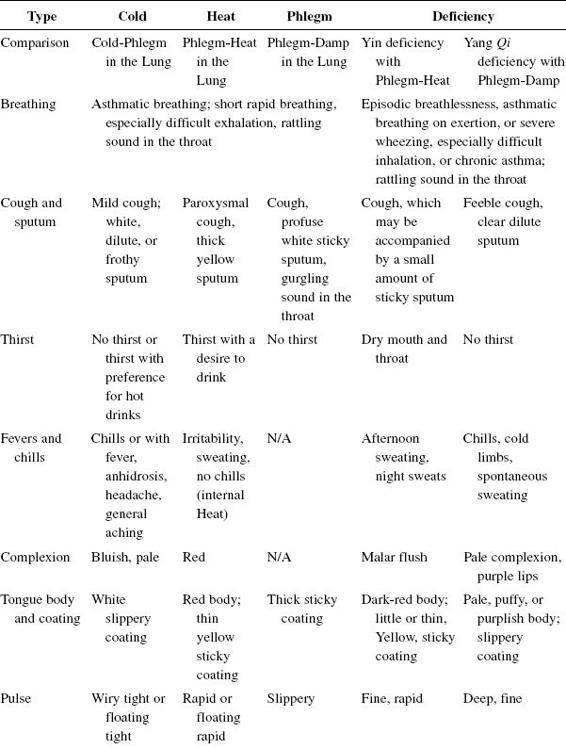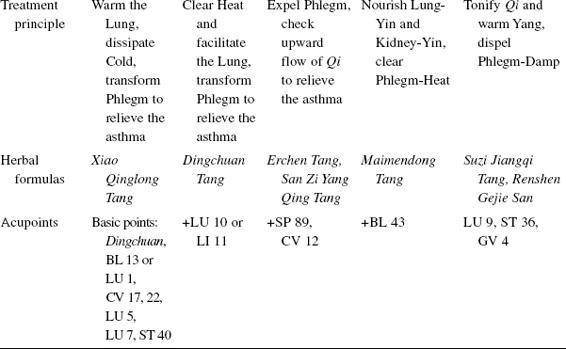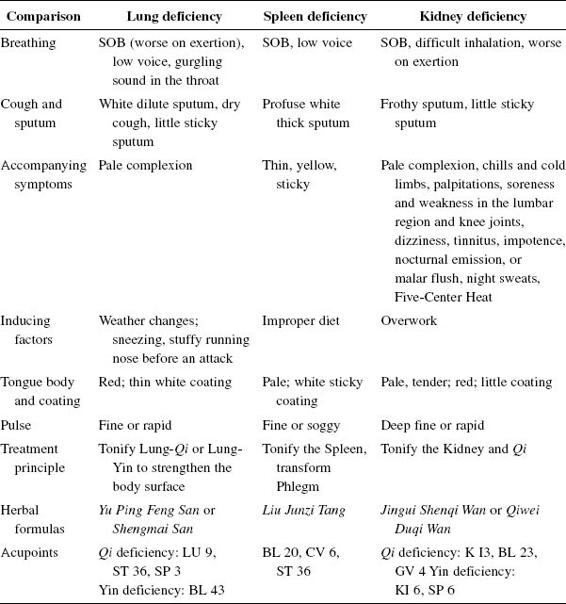The Introduction of Asthma
Definition
A common illness characterized by repeated attacks of paroxysmal dyspnea with wheezing. It is called Xiao Chuan in TCM. “Xiao” means “asthma” and “chuan” means “dyspnea.”
Clinical features
In most patients, an asthma attack begins with a nonproductive cough and wheezing, usually followed by tightness in the chest and dyspnea. Attacks frequently occur at night and during sleep. They usually do not last longer than several hours, and resolve spontaneously or with therapy. The end of an attack is usually heralded by a change to a productive cough with expectoration of mucous plugs and casts.
The Etiology of Asthma
- Invasion of exogenous pathogenic factors like Wind-Cold or Wind-Heat in the Lung leads to impairment of descending and dispersing of the Lung, which may produce Phlegm.
- Overindulgence in raw, cold, sweet, greasy, or sea food may damage the Spleen and produce Phlegm.
- Congenital deficiency or long-term illness injures the Kidney, Spleen, and Lung.
The Pathology of Asthma
Chief pathological factor
Phlegm is the chief pathological factor and serves as the “hiding root” for asthma. Without Phlegm, an asthma attack will not be triggered. Phlegm may come from Spleen, Kidney, and Lung Pathology
.
Phlegm, water retention, and Dampness all result from abnormal water metabolism and have the same nature.
Major organs involved
The chief organ is the Lung, but the Spleen and Kidney are also related.
Chief pathology
Phlegm mixed with Qi blocks the air passage and impairs the dispersing and descending functions of the Lungs.
Common patterns
An asthma attack usually presents as an excess pattern, whereas the remission stage usually presents as a deficiency pattern (see differentiation Table 18).
Prognosis
In senior patients, Kidney-Qi naturally declines. So, for these patients, asthma is very difficult to cure but it can be managed.
In adolescent patients the prognosis is better, because Kidney-Qi continues to increase until age 28 in females and age 32 in males. Therefore, asthma may be curable in these patients.
Herbal therapy in the non-attack stage is very important, in order to decrease the frequency and severity of asthma attacks.
How to Diagnose and differentiate Asthma(see Table 18andTable 19)
Disease differentiation
Asthma and dyspnea are very similar diseases, but dyspnea is characterized by difficult breathing only whereas asthma is characterized by wheezing.
Syndrome differentiation
(1) Excess
- Duration: acute onset; short duration.
- Breathing: loud, rough breathing; difficult exhalation.
- Voice: loud, gurgling sound.
- Pulse: Rapid, Firm.
- Constitution: looks strong.


Basic points: Dingchuaan, BL 13 or LU 1, CV 17, 22, LU 5, 7, ST 40.
(2) Deficiency
- Duration: slow, chronic onset; long duration.
- Breathing: low breathing; difficult inhalation.
- Voice: not obvious/low, gurgling sound.
- Pulse: Deep, Fine or Fine, Rapid.
- Constitution: looks weak.
For deficiency, determine whether it is Yin or Yang deficiency and which Zang-Fu organs are involved. Yang-Qi deficiency usually involves LU, SP, KI, or sometimes HT.
Yin deficiency usually involves LU or KI.
The Treatment of Asthma
Principle of treatment
(1)During an attack
- General: remove the pathogenic factor(s) by transforming Phlegm and regulating Qi.
- For Cold Phlegm: warm and transform Cold Phlegm; disperse Lung-Qi.
- For Heat Phlegm: clear and transform Heat Phlegm; descend Lung-Qi.
- For Cold wrapping Fire: warm the outside and clear Heat inside.

(2)During the remission stage
- General: tonify Zheng Qi.
- For Yin deficiency: nourish Yin.
- For Yang deficiency: warm and tonify Yang.
- Also tonify Zang–Fu organs as appropriate.
Acupuncture
(1)Excess type (during an attack)
Hand Taiyin, Hand Yangming, and CV Meridians are chosen. Use the reducing method. Moxa is added for the Cold type.
(2)Deficiency type
Hand Taiyin Meridian, Back Shu points are chosen. The tonifying method and moxa are applicable.
By symptom:
- Excessive Phlegm: CV 12, ST 40.
- Chest pain: LU 1.
- Severe dyspnea: CV 22.
Moxibustion
Dr. Lintai Xu said, “There is no cure for asthma without moxa.”
One treatment for asthma that is used in China involves scarring moxibustion over a three-year time frame. Each year, one treatment is done in the summer.
- First year: scarring moxa in summer on GV 14, BL 13.
- Second year: scarring moxa in summer on BL 12, GV 10.
- Third year: scarring moxa in summer on BL 43, BL 11.
Use nine units of moxa per point and burn down completely.
Herbal external application
Baijiezi 20 g
Yanhusuo 20 g
Gansui 10 g
Xixin 10 g
Shexiang 0.6 g
Get the powder form of these herbs and mix them together. On a hot day in summer, mix ginger juice and these herbs to make a paste. Apply the paste to BL 13, BL 43 or Bailao for 1–2 h. The patient will normally feel a warm or comfortable burning sensation.
Plum blossom needle
During an attack:
- Tap on the chest, lumbar and ribcage.
- Combine with the elbow, the palm, the base of the throat, and the side of the trachea.
During remission, tap on:
- The lung, Spleen, or Kidney Meridian based on the pattern.
- Nodules or tender spots if you find them.
Herbal Medicine
See the charts titled “During an Asthma Attack” and “During the Remission Stage.”
Patent medicines used over the long term can also help to improve the constitution. They are especially good for treatment during the remission stage.
Suggestions
- Keep warm when the weather turns cold, to prevent EPF invasion.
- Quit smoking. Avoid stimulating gases (those with strong odors, such as gasoline), dust, pollen, etc.
- Eat fresh, light food without a heavy taste (e.g. too salty or too sweet). Avoid raw, cold food or greasy food to prevent production of Phlegm. Also avoid spicy food and seafood.
- Avoid overstrain and emotional frustration. Keep stress to a minimum.
- Ask the patient to observe what triggers the asthma attacks (everyone has different triggers) and try to avoid them.
- Educate the patient that treatment is also necessary during remission so as to desensitize the patient and help build a stronger constitution.

